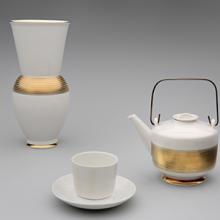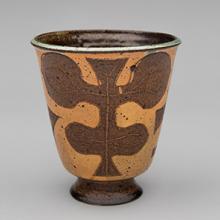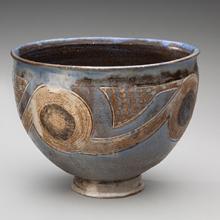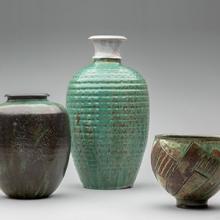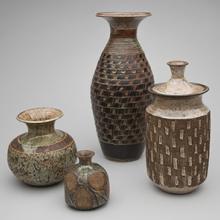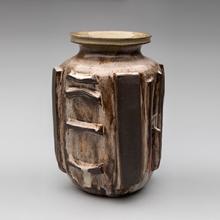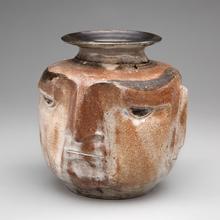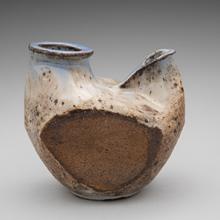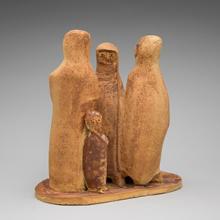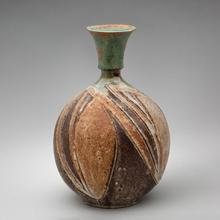Terminal 2












Vase and teapot 1928–33
Marguerite Wildenhain (1896–1985)
Halle, Germany
porcelain, glaze
Collection of Forrest L. Merrill
FLM 2064, 2071
L2015.1701.113, .114
Royal Berlin coffee cup and saucer 1931
Marguerite Wildenhain (1896–1985)
Halle, Germany
porcelain, glaze
Collection of Forrest L. Merrill
FLM 3743
L2015.1701.117 .01-.02
Wildenhain at the Municipal School of Fine and Applied Arts
Marguerite Wildenhain accepted a position as head of ceramics at the Municipal School of Fine and Applied Arts in Halle, Germany, in 1926. Wildenhain not only managed the staff and student apprentices, but also determined the clays, glazes, and firing techniques that would be used at the school. She soon established a highly regarded pottery workshop and was approached by the director of the famous porcelain factory Royal Berlin to form a partnership. The manufactory built a porcelain kiln to their specifications at the school in Halle. Wildenhain then began designing porcelain tableware, vases, and other objects for Royal Berlin to mass produce.
The collaboration was a great success. The modern, unadorned designs followed the Bauhaus doctrine, “form follows function.” Her wares were shown in Paris, London, Brussels, Amsterdam, and as far as New York. Wildenhain later recalled arriving in the United States in 1940 and being invited for tea by one of the trustees of the San Francisco Museum of Art (now SFMOMA). To her surprise and pleasure, “the butler brought tea that was served in a tea set that I had made at Royal Berlin.” The trustee had purchased it in Paris, unaware that it was one of Wildenhain’s designs.
Oil bottle c. 1935
Marguerite Wildenhain (1896–1985)
Het Kruikje (The Little Jug)
Putten, Holland
Stoneware
Collection of Forrest L. Merrill
FLM 2311
L2015.1701.110
Jug 1933–40
Marguerite Wildenhain (1896–1985)
Het Kruikje (The Little Jug)
Putten, Holland
ceramic, glaze
Collection of Forrest L. Merrill
FLM 521
L2015.1701.111
Covered vessel c. early 1930s
Marguerite Wildenhain (1896–1985)
State School of Fine and Applied Arts
Halle, Germany
ceramic, glaze
Collection of Forrest L. Merrill
FLM 2532
L2015.1701.106
Wildenhain in Holland and the U.S.
When the Nazis threatened to close the Municipal School of Fine and Applied Arts in Halle, Germany, if Wildenhain did not resign, she left her position there and moved with her husband to the Netherlands in 1933. They purchased a pottery studio in the town of Putten, which they named Het Kruikje or The Little Jug. In Holland, Wildenhain created mostly handmade individual pieces with her husband at their shop, Het Kruikje or The Little Jug, in addition to designing industrially produced tea and coffee sets for a Dutch manufactory. But as she faced further threats from the advancing Nazis, Wildenhain approached the American consulate, where she learned that the quota for German-born citizens was filled for the next eighteen months. French-born Wildenhain would have to leave for the United States without her German-born husband Frans. She took only a few possessions with her including her mattress, later recounting, “I figured that, if I did arrive safely in the States and could lay that mattress down somewhere, even in the wilderness, I would be able to settle down and begin to work.”
She arrived in New York in March of 1940. After spending a brief period there, she left for the West Coast, arriving in San Francisco in May of 1940. Wildenhain soon accepted a job at the California College of Arts and Crafts in Oakland in hopes of securing a teaching position for her husband, which would allow him to immigrate sooner. However, he was inducted into the German army before she had the opportunity to do so. Unhappy teaching in Oakland, she moved to Pond Farm, deciding that it would “be here that I would lay down that mattress and start to make pots and build a new life.”
Beaker vase with plant forms 1957
Marguerite Wildenhain (1896–1985)
Pond Farm, Guerneville
stoneware, glaze
Collection of Forrest L. Merrill
FLM 406
L2015.1701.031
Pond Farm: The Beginnings
When Marguerite Wildenhain first arrived at Pond Farm in the summer of 1942, there was nothing there except an old barn where she and Gordon Herr decided that her workshop would be located. They cleaned out the barn and made it habitable using scrap and salvage because building materials were difficult to acquire during World War II. While she worked on converting the barn, Wildenhain camped outside under walnut trees and cooked on a small sheepherder-stove. After a few months, Herr built a small cabin for her that she described being “like a ship’s cabin, one single room, 12 x 20 feet, one cold water faucet in the kitchen-nook, and a space for a three burner gas plate.” There was no electricity; she had butane gas, and for light and heat, Wildenhain used kerosene.
Throughout this challenging period, Wildenhain recalled feeling “so elated at having built-up whatever there was practically with my own hands that weeks and months passed for me in real enthusiasm and hope.” Within a couple of years, she would have electricity and an indoor bathroom. In 1949, in this humble setting, she welcomed her first students to Pond Farm and immediately began filling up her two-month summer school sessions. Today, Pond Farm is listed in the National Register of Historic Places.
Wall panel c. 1940s–60s
Marguerite Wildenhain (1896–1985)
Pond Farm, Guerneville
stoneware, glaze
Collection of Forrest L. Merrill
FLM 1038
L2015.1701.066
South American Influence
The first time Marguerite Wildenhain saw a collection of Peruvian pottery at the Musée de L’Homme in Paris, she felt awestruck. Her admiration for Greek and other classical pots “went flying out of the museum window on contact with those strangely powerful and imaginative pots from South America.” From that day on, she was determined to visit Peru. During the 1960s, she attended the World Crafts Council Meeting in Peru. Over the years, during the winter months, she also explored Mexico, Bolivia, Ecuador, Colombia, and Central America. The pottery and cultures of these countries inspired many of Wildenhain’s ceramics. She sketched figures of indigenous peoples and landscapes that she observed on her trips, then carved and painted these scenes on bowls, vases, tiles, and wall plaques, as well as sculpting figurines. Many of her works portray village life, the Aymara and Quechua Indians of Peru, sheep herds, and other animals of the Andes.
Bowl 1940s–50s
Marguerite Wildenhain (1896–1985)
Pond Farm, Guerneville
stoneware, glaze
Collection of Forrest L. Merrill
FLM 1027
L2015.1701.022
European Artists at Pond Farm
Pond Farm was the creation of architect Gordon Herr and his heiress wife, Jane Herr of San Francisco. Their intent was to create a school and refuge for artists of various disciplines. They purchased 160 acres of farmland in Sonoma County to create their Bauhaus-inspired colony. The rise of Nazism created a diaspora of European artists, particularly those of Jewish heritage. Many of these artists had an enormous influence on art, craft, and design in the United States, including Wildenhain. She was the first to move to Pond Farm in 1942. Her ceramic sculptor-husband Frans Wildenhain(1905–80), metalworker Victor Ries (1907–2011), and weaver Trude Guermonprez (1910–76) later joined her. Together, the group made up the original artists’ colony and school established by the Herrs. Pond Farm Workshops opened in 1949, but differences in opinions led to the demise of the artists’ colony after only a few years.
Only Wildenhain remained at Pond Farm, where she ran a successful pottery studio and school until her retirement in 1980. In her studio, Wildenhain made functional and decorative stoneware using modest glazes, often incising designs into her works. She typically marked her stoneware with a small jug motif inscribed in the well of the foot.
Vase c. 1940s–50s
Marguerite Wildenhain (1896–1985)
Pond Farm, Guerneville
stoneware, glaze
Collection of Forrest L. Merrill
FLM 1025
L2015.1701.006
Textured vase mid-1960s
Marguerite Wildenhain (1896–1985)
Pond Farm, Guerneville
stoneware, glaze
Collection of Forrest L. Merrill
FLM 1066
L2015.1701.001
Footed bowl c. 1965
Marguerite Wildenhain (1896–1985)
Pond Farm, Guerneville
stoneware, glaze
Collection of Forrest L. Merrill
FLM 499
L2015.1701.005
Vase and spotted bottle c. 1970s
Marguerite Wildenhain (1896–1985)
Pond Farm, Guerneville
stoneware, glaze
Collection of Forrest L. Merrill
L2015.1701.039, .099
Vase and covered jar c. 1965-1970
Marguerite Wildenhain (1896–1985)
Pond Farm, Guerneville
stoneware, glaze
Collection of Forrest L. Merrill
FLM 524, 2279
L2015.1701.014, .073a,b
Vessel c. 1960s–70s
Marguerite Wildenhain (1896–1985)
Pond Farm, Guerneville
stoneware, glaze
Collection of Forrest L. Merrill
FLM 3372
L2015.1701.129
Face vessel 1970s
Marguerite Wildenhain (1896–1985)
Pond Farm, Guerneville
stoneware, glaze
Collection of Forrest L. Merrill
FLM 1005
L2015.1701.020
Bottle with two openings c. 1972
Marguerite Wildenhain (1896–1985)
Pond Farm, Guerneville
stoneware, glaze
Collection of Forrest L. Merrill
FLM 417
L2015.1701.023
Three female figures and child c. 1970s
Marguerite Wildenhain (1896–1985)
Pond Farm, Guerneville
stoneware, glaze
Collection of Forrest L. Merrill
FLM 2496
L2015.1701.128
Carved bottle c. 1972
Marguerite Wildenhain (1896–1985)
Pond Farm, Guerneville
stoneware, glaze
Collection of Forrest L. Merrill
FLM 414
L2015.1701.002
